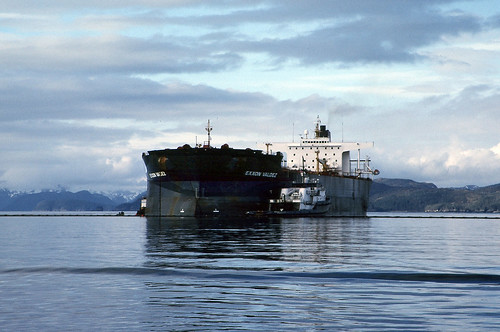2015年1月1日起,美國海域將禁止單殼油輪駛入。
1989年,埃克森(Exxon)旗下的瓦德茲號在阿拉斯加發生漏油事件後,油汙法於1990年生效,要求所有的新油輪和油罐船,都必須設計成雙殼,避免類似的事件再次發生。然而,油汙法生效後的25年間,單殼油輪都未被禁止航行,現在則將正式走入歷史,不得航行於美國海域,運載石油。
單殼油輪正式走入歷史
美國國家海洋和大氣管理局(NOAA)表示,將逐步導入雙殼設計的規定,因為很難將單殼油輪改造成雙殼,且一下子令單殼油輪全部退役,恐為難全球航運業。
1月1日的期限並未造成太大的衝擊,因為多年來大部分駛入美國港口的油輪都是雙殼。
過去部分雙殼油輪的撞擊意外中,完全沒有造成任何漏油。例如瓦德茲號漏油事件20年後,挪威油輪SKS Satilla撞上海面下鑽油平台,船身側面撞出一個大洞,但船上的4千1百萬加崙原油,一滴也沒有漏。
不過NOAA也承認,雙殼設計並不保證完全不會漏油,不過可以減少漏油量,尤其在低速時擱淺撞擊時。
多一層保護 雙殼裝載不易漏油
1992年,油汙法生效兩年後,預防船隻污染國際公約(MARPOL Convention)也修改了內容,要求所有新船隻必須是雙殼設計。
在單殼油輪上,原油和海水之間只隔了一層鋼。如果船發生撞擊或擱淺,就很可能漏油。油汙法生效後,仍持續發生單殼油輪漏油事件。
2004年,賽普勒斯藉油輪阿索斯號在紐澤西保羅斯伯勒煉油廠欲停泊時撞擊達拉威河中的錨,高達26萬5千加崙原油流入費城一帶河川。
雙殼油輪則多了一層鋼,兩層鋼之間有空隙,成為海水和原油之間的緩衝空間。
貨輪、遊輪不受限 仍可能釀成漏油意外
雖然雙層設計較可能避免漏油,但是雙殼的要求規範僅限於油輪和油罐船。貨輪、遊輪仍可能是單層設計。這些船隻載油量雖遠少於油輪,大型船隻仍可能運載大量的燃料油,也曾發生大規模漏油事件。
2007年11月,香港船隊管理有限公司的單殼貨輪中遠釜山號撞上舊金山-奧克蘭海灣大橋,53,569加崙船用燃料油流入舊金山灣。
漏油遍佈馬林岬角至聖馬刁郡,造成那年冬天7,000隻鳥和29%產卵中鯡魚死亡。
As of January 1, 2015 single-hull oil tankers are no longer allowed in U.S. waters.
The Oil Pollution Act of 1990, passed after the disastrous 1989 Exxon Valdez oil spill in Prince William Sound, Alaska, required that all new tankers and tank-barges be built with double hulls to prevent similar oil spills.
For the first 25 years after the law was passed, single-hull tankers were still allowed to operate, but now those tankers are at the end of their operational lives and can no longer carry oil as cargo in U.S. waters.
The National Oceanic and Atmospheric Administration, NOAA, says the double-hull requirement was phased in gradually “because of the difficulty of converting existing single-hull tankers to double hulls, and retiring the single-hull tankers more rapidly would have been a major disruption to world shipping.”
The January 1, 2015 deadline did not bring about a major change because most of the tankers calling on U.S. ports have had double hulls for years.
In some collisions involving these double-hull tankers, not a drop of oil was spilled.
Twenty years after the Exxon Valdez oil spill, for instance, the Norwegian tanker SKS Satilla collided with a submerged oil rig in the Gulf of Mexico. The collision tore a huge hole in the tanker’s side, but none of the 41 million gallons of crude oil on board was spilled.
But single-hull tankers have spilled oil in the years since the Oil Pollution Act became law.
In 2004, the Cyprus-registered tanker Athos I struck a submerged anchor in the Delaware River while preparing to dock at a refinery in Paulsboro, New Jersey. The spill of 265,000 gallons of heavy crude oil fouled the river near Philadelphia, Pennsylvania.
For vessels with a single hull, one plate of steel is all that separates the oil on board from the ocean. If the hull is punctured from a collision or grounding, an oil spill is likely to occur.
A ship with a double hull has two plates of steel with empty space between them, essentially a hull within a hull. The second hull creates a buffer zone between the ocean and the oily cargo.
Although they are likely to prevent oil spills, the double hull requirements apply only to tankers and tank barges. Container ships, freighters, cruise ships, and other types of vessels are still built with single hulls. While these ships carry a lot less oil than a tanker, a large non-tank vessel can still carry a lot of fuel oil, and some have caused some big spills.
For instance, when the single-hull cargo ship Cosco Busan, operated by Fleet Management Ltd of Hong Kong, struck the San Francisco-Oakland Bay Bridge in November 2007 it spilled 53,569 gallons of bunker fuel oil into the San Francisco Bay.
The spill fouled beaches from the Marin Headlands to San Mateo County, killed nearly 7,000 birds and wiped out as much as 29 percent of the spawning herring that winter.
Double hulls don’t prevent all oil spills from tankers, NOAA acknowledges, but the design has been credited with reducing the amount of oil spilled, especially during low-speed groundings and collisions.
In 1992, two years after the Oil Pollution Act, the International Convention for the Prevention of Pollution from Ships, called the MARPOL Convention, was amended to require all newly built tankers have double hulls.
※ 全文及圖片詳見:ENS






